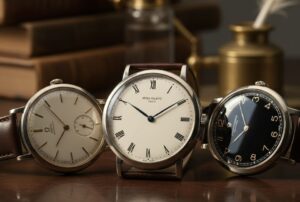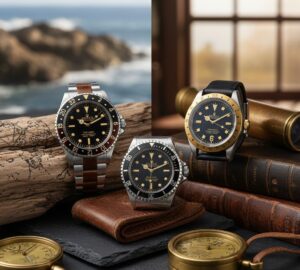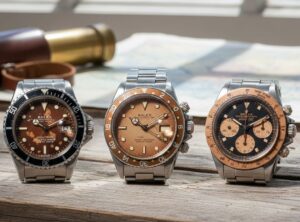The Hidden Language of Vintage Watch Dials
In an age of smartwatches and digital precision, there’s a profound, almost poetic allure to the tick-tock of a vintage mechanical watch. A vintage watch dial tells its story on the dial long before you look at the movement. Be it an alluring green dial watch, an enamel dial, or a matte dial, these components hold the scars of time, the warmth of age, and the personality that turns a simple tool into a collectible treasure.
Collectors chase certain vintage watch dials the way art lovers chase rare canvases. Understanding the nuances of vintage and antique watch dials isn’t just about appreciating pretty faces; it’s about decoding the silent language of horology, a journey that deepens one’s connection to these mechanical marvels.
This guide explains the key types of dials found in vintage and antique watches and the major types of subdials. Collectors use these details every day to judge rarity, authenticity, and value. Once you know what to look for, you will never see a vintage watch the same way again.

Also Read: The Allure of Vintage Watches
What is a Watch Dial?
https://www.youtube.com/watch?v=08cJy9T_gao
Video Credit: Teddy Baldassarre
At its most fundamental, the watch dial is the surface on which the time is indicated, featuring hour markers, minute tracks, and often the brand’s logo. But in the realm of vintage watches, a dial is far more than a mere display. It’s the primary aesthetic element, a complex interplay of colour, texture, typography, and finishing techniques that defines a watch’s identity and its era.
What is a Sub-Dial?
A sub-dial, also known as a subsidiary dial or counter, is a smaller dial positioned within the main watch dial. These are typically used to display additional functions (complications) beyond just hours, minutes, and seconds.
Kinds of Vintage Watch Dials: A Canvas of Craftsmanship
- Enamel Dials

Enamelled watch dials are renowned for their exceptional durability and vibrant colouration, achieved through various complex techniques. Enamel dials are made of powdered glass fused to metal through high heat. They look smooth, glossy, and pure.
Why collectors love it:
Enamel dials stay vibrant and elegant even after a century.
Example:
Patek Philippe used enamel dials in many early references, especially in the early twentieth-century watches.
- Gilt Dials

With an aura of opulence and timeless elegance, A gilt dial uses metallic text and markers that appear to rise from a glossy black surface. Gilt dials have a warm, golden look.
Why collectors love it:
When a vintage gilt dial remains glossy and clean, its value climbs quickly.
Example:
Rolex used gilt dials in early Submariner and GMT references, which are now among the most sought-after vintage sports watches.
- Tropical Dials

Tropical dials start life as black or dark dials. Over time, sunlight and heat cause the pigment to shift into shades of brown, caramel, or even copper. No two tropical dials look alike.
Why collectors love it:
Ageing is natural and impossible to replicate perfectly. A well-aged tropical dial can double a watch’s desirability.
Example:
Omega Speedmasters with true tropical dials are prized by collectors.
- Linen Dials
Linen dials have a woven, fabric-like texture created through fine cross-hatching.
Why collectors love it:
Linen dials catch light in subtle ways and feel refined.
Example:
Vintage Rolex Datejust models often came with linen dials that remain favourites among collectors.
- Sector Dials
Sector dials break the dial into distinct rings or zones with simple lines. They were popular in the 1930s and are known for clean, geometric symmetry.
Why collectors love it:
Sector dials feel both vintage and modern.
Example:
Longines produced some of the most iconic sector dials, many of which are now highly collectible.
- Porcelain Dials
Porcelain dials are a variation of enamel, but thicker and more fragile. They look creamy and smooth, with strong colour and crisp numerals.
Why collectors love it:
These dials age gracefully and retain a classic, elegant look that suits antique watches.
Example:
Many early Vacheron Constantin pocket watches used porcelain dials that still appear flawless today.
- Sunburst Dial
Sunburst dials radiate fine lines from the centre outward. This creates a shifting shine when the watch moves.
Why collectors love it:
The effect adds life and dimension. Sunburst finishes look especially good in silver, blue, and champagne tones.
Example:
Seiko used beautiful sunburst finishes across its vintage King Seiko and Grand Seiko models.
- Painted or Handcrafted Dials

These dials feature hand-painted logos, numerals, or scenes. They are common in early watches when mass production was limited.
Why collectors love it:
No two are identical. They reflect the craftsmanship of the era before automation.
Example:
Audemars Piguet produced early dress watches with painted Roman numerals that still attract high interest.
- Brushed Dials
Brushed dials are known for their fine, linear texture created by carefully applied strokes across the surface. This finish gives the dial a bright yet controlled shine.
Why collectors love it:
Brushed dials hold up well over time and often show gentle ageing that adds charm
Example:
The Omega Seamaster Aqua Terra line is known for its refined brushed dials.
- California Dials
California dials stand out for their split layout that uses Roman numerals on the upper half and Arabic numerals on the lower half. The style appeals to buyers who want something different from the usual dial formats.
Why collectors love it:
The layout is instantly recognizable. It feels vintage, rugged, and functional.
Example:
Panerai Radiomir California 47mm 3 Days Power Reserve Watch.
Understanding Vintage Watch Sub Dials
Sub dials add function and purpose. Below are the most important types of sub-dials found in collectible vintage watches.
- Small Seconds Sub Dial

Instead of a sweeping second hand, the seconds are placed in a small dial, often at the 6 o’clock position.
Example:
The Omega Calatrava style watches from the 1940s and 1950s used elegant small seconds sub dials.
- Chronograph Sub Dials

Chronographs usually have two or three sub dials. Each serves a different timing purpose.
- Minute counter: Tracks elapsed minutes.
- Hour counter: Tracks elapsed hours.
- Running seconds: Tracks regular seconds while the main chronograph hand stays still.
Example:
The Rolex Daytona is one of the most iconic multi-sub dial chronographs of all time.
- Moon Phase Subdial
Moon phase subdials offer an artistic and often romantic depiction of the lunar cycle.
Example:
The IWC Portuguese Perpetual Calendar Moonphase is an excellent example.
- Calendar Sub Dials
Some vintage watches use sub dials to display the day, date, month, or moon phase.
Example:
Patek Philippe triple calendar watches often use sub dials for day and month indicators.
- GMT Subdial
GMT subdials are in watches designed for globetrotters and professionals operating across different time zones. A GMT subdial displays the time in another time zone.
Example:
Panerai Submersible Luna Rossa GMT 47mm Carbotech
The Enduring Appeal of Watch Dials
The beauty of vintage watch dials and sub-dials lies in their ability to tell multiple stories simultaneously: the story of time, the story of technological evolution, and the story of aesthetic trends.
From the golden gleam of a gilt dial to the rugged patina of a tropical one, and the functional elegance of a chronograph, these faces of time are portals to the past. They remind us that true craftsmanship transcends fleeting trends, offering enduring beauty and a tangible connection to the art of horology.






